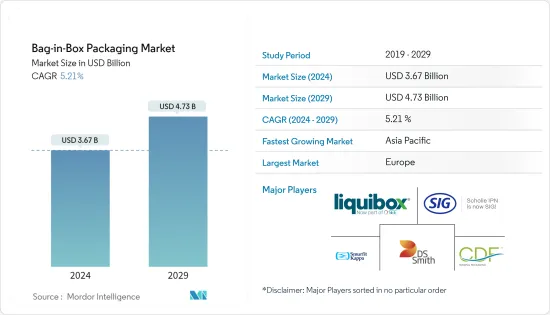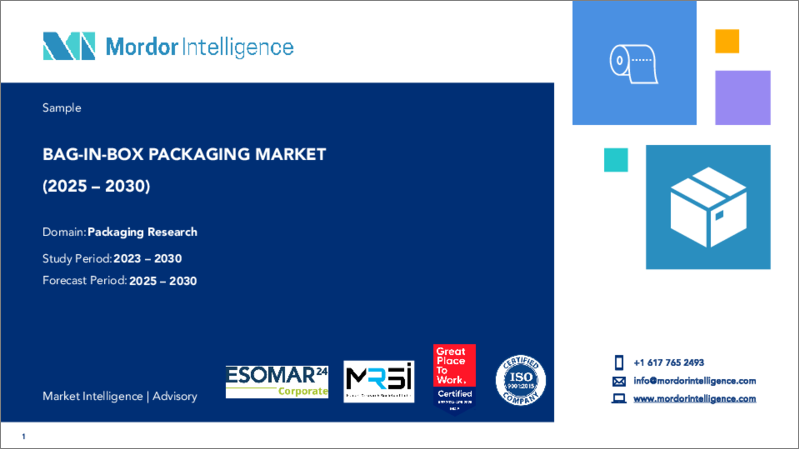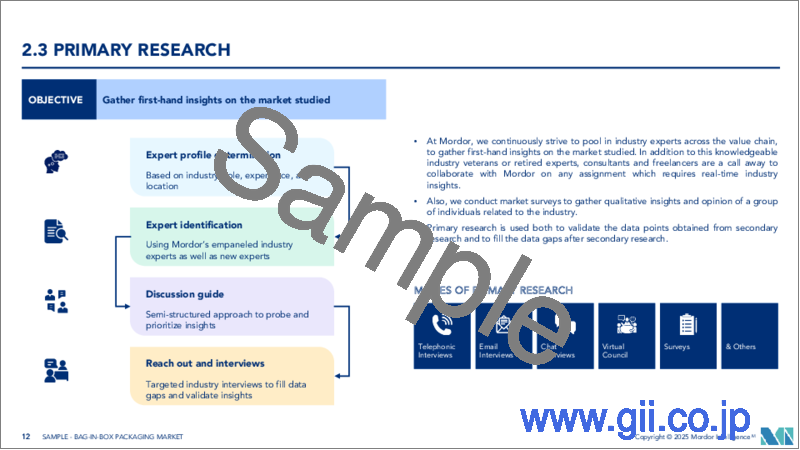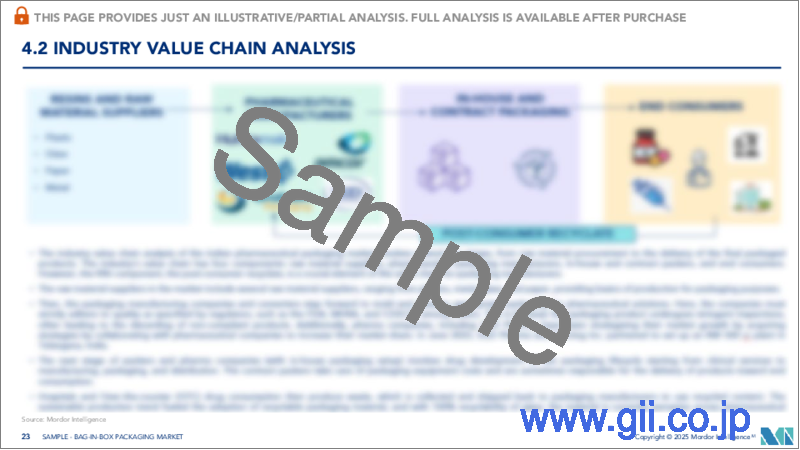|
|
市場調査レポート
商品コード
1521899
バッグインボックス(BIB)包装:市場シェア分析、産業動向と統計、成長予測(2024~2029年)Bag-in-Box Packaging - Market Share Analysis, Industry Trends & Statistics, Growth Forecasts (2024 - 2029) |
||||||
カスタマイズ可能
適宜更新あり
|
|||||||
| バッグインボックス(BIB)包装:市場シェア分析、産業動向と統計、成長予測(2024~2029年) |
|
出版日: 2024年07月15日
発行: Mordor Intelligence
ページ情報: 英文 121 Pages
納期: 2~3営業日
|
全表示
- 概要
- 目次
バッグインボックス(BIB)包装の市場規模は2024年に36億7,000万米ドルと推定され、2029年には47億3,000万米ドルに達すると予測され、予測期間(2024-2029年)のCAGRは5.21%で成長する見込みです。

主なハイライト
- バッグインボックス(BIB)包装は、頑丈な箱の中にフレキシブルな袋を収納した革新的なソリューションです。このセットアップは、液体や半液体を保管・分配するための効率的で費用対効果の高い、環境に優しい方法を提供します。バッグは通常、製品の完全性を保つために複数のフィルム層から作られており、分注タップを備えているため、簡単かつ制御された注入が可能です。この包装形態は、その汎用性と無数の利点により、飲食品、医薬品、工業製品などの業界で幅広く使用されています。
- BIBパッケージの際立った利点の一つは、使いやすいディスペンサーです。その設計により、空気を混入させることなくスムーズに製品を取り出すことができ、酸化や汚染のリスクを最小限に抑えることで製品の保存期間を延ばすことができます。例えば、2023年3月、Smurfit Kappa社は、特許を取得したVitop Unoタップをデビューさせ、市場初のバッグ・イン・ボックス用途のタンパー・プロテクションを取り付けた。このタップは、使いやすさを追求したもので、こぼれや無駄を最小限に抑える制御された流れを保証します。廃棄時には、消費者は適切なリサイクルのために、タップを含め、箱と袋を分別することが推奨されます。
- 最新のBIBシステムは、酸素、光、湿気から優れた保護を提供し、製品の鮮度を保つハイバリアフィルムを備えています。袋製造の進歩により、様々な充填・保存条件に耐えうる、より耐久性のある柔軟な素材が使用されるようになった。無菌BIBシステムのような技術革新は、防腐剤を使用せずに腐敗しやすい製品の包装を可能にし、ジュース、乳飲料、その他の繊細な飲料に理想的なものとなっています。例えば、2024年4月、著名なワイン生産者であるアリレオ社は、シチリアの自然派箱入りワインに、より持ち運びしやすい1.5リットルのフォーマットを導入し、箱入りワインに対する認識を再構築することを目指しました。アリレオがバッグ・イン・ボックス方式を採用したのは、従来のガラス瓶に比べて軽量であるため、輸送時の排出量が削減され、カーボンフットプリントが小さくなるからです。
- さらに、BIBパッケージは、持続可能性への関心の高まりと共鳴しています。バッグは軽量で折りたたみ可能なため、特に硬質容器と比較した場合、輸送コストと二酸化炭素排出量を削減できます。外箱は通常、リサイクル可能な段ボールで作られており、BIBパッケージングの環境に優しいプロファイルをさらに強化しています。この包装のデザインは、製品の無駄を最小限に抑え、従来の硬質包装とは対照的に、大きな残留物なしにほぼ完全な調剤を保証します。
- BIB包装はその利点にもかかわらず、課題にも直面しています。高い材料費、特に特殊な袋や箱は生産者の予算を圧迫します。慎重な取り扱いや保管の必要性など、ロジスティクスの複雑さが運用上のハードルを高めています。包装は内容物を汚染や腐敗から保護する必要があるため、長期的な製品品質の確保が最も重要です。
バッグインボックス(BIB)包装市場の動向
飲料セクターからの需要増加が市場成長を助ける
- 飲料セクターからの需要の高まりは、バッグインボックス(BIB)包装市場に大きな影響を与えています。効率性と費用対効果で知られるこの包装ソリューションは、ワイン、ジュース、ノンアルコール飲料などの製品に飲料メーカーが採用するケースが増えています。主な利点は、長期間にわたって飲料の鮮度と品質を保つことができる点にあります。従来のボトルや缶とは異なり、バッグインボックス(BIB)包装は空気に触れる機会を最小限に抑え、酸化や腐敗を抑えることができるため、ワインやフレッシュジュースなどの製品には特に有益です。
- 2023年11月、パッケージング企業のアラン・グループは、大成功を収めた第一世代のプレミアム・フレックスBIBに続く、バッグインボックス・プレミアム・フレックスの第二世代を発表しました。この改良版は、厳しい研究開発によって作られ、持続可能な飲料輸送とリサイクル性を提供します。
- バッグインボックス(BIB)包装は、その比類なき保存能力により、非炭酸清涼飲料の分野でニッチを切り開いています。飲料を空気や光から遮断するこの包装形態は、特にジュース、アイスティー、スポーツ飲料など、酸素に触れるとすぐに腐敗しやすい飲料の風味維持に優れています。
- KNAVのレポートでは、2023年のインド市場のシナリオとして、ノンアルコール飲料市場の19%以上を占めるジュースとネクターにスポットを当てています。これらの飲料用のバッグインボックス(BIB)包装は、費用対効果だけでなく、保存期間の延長や使い勝手の良さからも注目されています。この形態は、内容物を光や空気から保護し、風味を保つと同時に、保管や調剤が容易です。
- さらに、バッグインボックス(BIB)包装へのシフトは、費用対効果と環境にやさしいです。軽量でスペース効率に優れ、製造コストや輸送コストで従来の包装を凌駕します。プラスチックの使用量が少なく、リサイクル性に優れているため、環境意識の高い消費者の共感を呼び、競争力を高めています。
欧州が大きな成長を遂げる
- 欧州、特にフランスやイタリアといった化粧品の中心地では、パーソナルケア製品のバッグインボックス(BIB)包装が増えています。この包装方法は、ローション、クリーム、液体石鹸などに使用され、汚染や酸化に対する優れた保護を提供します。バッグインボックス(BIB)包装はまた、より持続可能でコスト効率に優れています。プラスチック廃棄物を削減し、厳しい環境基準や環境に優しい製品を求める消費者の嗜好に合致しています。
- トランスフェア社によると、ドイツのフルーツジュース販売量は2023年に14.1メガリットルに達します。ジュース、アイスティー、フレーバーウォーターなどの非炭酸清涼飲料は、空気や光への暴露を防ぐことで鮮度を保ち、保存期間を延ばすことができるため、バッグ・イン・ボックス形式で包装されることが増えています。
- 欧州諸国では、効率性と持続可能性の面で多くの利点があるため、潤滑油のバッグインボックス(BIB)包装の採用が増えています。この包装形態は、潤滑剤を汚染や酸化から保護し、製品の品質と寿命を保証します。さらに、バッグ・イン・ボックスのソリューションは、従来の金属製やプラスチック製の容器よりも場所を取らず軽量であるため、輸送や保管が容易でコスト効率が高いです。このパッケージングへのシフトは、欧州の環境規制や、より持続可能な選択肢を求める消費者の嗜好にも合致しています。バッグ・イン・ボックスは使用する材料が少なく、リサイクル可能な場合が多いため、全体的な環境フットプリントを削減できます。
- 例えば、2023年12月、ドイツ製の高品質潤滑油ブランドであるLiqui Molyは、6種類の人気モーターオイルにバッグインボックス(BIB)包装を導入しました。さらに2023年3月には、ペトロナスルブリカンツインターナショナル(PLI)が欧州でペトロナス・シンティウム・バッグインボックス(BIB)を発売し、同社の持続可能性と循環の旅において重要な一歩を踏み出しました。PETRONAS Syntium BIBは欧州全域で販売され、様々な市場で環境に優しいスマートなパッケージング・ソリューションを提供します。
バッグインボックス(BIB)包装業界の概要
バッグインボックス(BIB)包装市場の競争は細分化されており、Smurfit Kappa、Scholle IPN、Liquibox、CDF Corporation、DS Smithなどの大手企業が存在します。市場には、大きな市場シェアを持つ企業が複数存在します。市場プレーヤーは、持続可能なパッケージングへの取り組みを通じてブランドの存在感を高めるため、製品のイノベーションに注力しています。
その他の特典:
- エクセル形式の市場予測(ME)シート
- 3ヶ月間のアナリスト・サポート
目次
第1章 イントロダクション
- 調査の前提条件と市場定義
- 調査範囲
第2章 調査手法
第3章 エグゼクティブサマリー
第4章 市場洞察
- 市場概要
- 産業バリューチェーン分析
- 業界の魅力度-ポーターのファイブフォース分析
- 買い手の交渉力
- 供給企業の交渉力
- 新規参入業者の脅威
- 代替品の脅威
- 競争企業間の敵対関係
- 現在の市場シナリオ
- 技術の進歩(BIBパッケージングフォーマットにおけるより簡単な調剤と先進技術の導入)
- 液体・半固体包装の最新動向分析
- 業界規制
第5章 市場力学
- 市場促進要因
- 飲料メーカーのBIB包装フォーマットに対する需要の高まり
- eコマースにおける利便性と環境に優しい包装へのニーズの高まり
- 市場の課題
- 代替包装形態による市場成長の課題
第6章 市場セグメンテーション
- 容量別
- 0~5リットル
- 5~10リットル
- 10リットル以上
- エンドユーザー産業別
- 飲料
- アルコール飲料
- ノンアルコール飲料
- 食品
- 医薬品
- 工業用(化学、塗料、コーティング)
- 医療・介護
- 飲料
- 地域別
- 北米
- 米国
- カナダ
- 欧州
- ドイツ
- 英国
- フランス
- イタリア
- アジア
- 中国
- インド
- 日本
- オーストラリア・ニュージーランド
- ラテンアメリカ
- ブラジル
- メキシコ
- 中東・アフリカ
- アラブ首長国連邦
- サウジアラビア
- 南アフリカ
- 北米
第7章 競合情勢
- 企業プロファイル
- Smurfit Kappa
- DS Smith PLC
- Liqui-Box Corp.
- Scholle IPN Corp.
- CDF Corporation
- Amcor Group GmbH
- Aran Group
- Goglio SpA
- Fujimori Kogyo Co. Ltd(Zacros Cubitainer)
- AstraPouch(Vine Valley Ventures LLC)
第8章 投資分析
第9章 市場の将来展望
The Bag-in-Box Packaging Market size is estimated at USD 3.67 billion in 2024, and is expected to reach USD 4.73 billion by 2029, growing at a CAGR of 5.21% during the forecast period (2024-2029).

Key Highlights
- Bag-in-box (BIB) packaging is an innovative solution with a flexible bag housed inside a sturdy box. This setup offers an efficient, cost-effective, and eco-friendly way to store and dispense liquids and semi-liquids. The bag, typically crafted from multiple film layers for product integrity, features a dispensing tap, enabling easy and controlled pouring. This packaging format finds wide application across industries like food and beverages, pharmaceuticals, and industrial products, owing to its versatility and myriad benefits.
- One standout advantage of BIB packaging is its user-friendly dispensing. Its design facilitates smooth product extraction without introducing air, extending the product's shelf life by minimizing oxidation and contamination risks. For example, in March 2023, Smurfit Kappa debuted its patented Vitop Uno tap, boasting the market's first attached tamper protection for bag-in-box applications. These taps are crafted for ease, ensuring a controlled flow that minimizes spillage and waste. At disposal, consumers are encouraged to separate the box from the bag, including the tap, for appropriate recycling.
- Modern BIB systems feature high-barrier films, offering superior protection against oxygen, light, and moisture, thus preserving product freshness. Advancements in bag manufacturing have led to the use of more durable, flexible materials capable of withstanding various filling and storage conditions. Innovations like aseptic BIB systems enable the packaging of perishable products without preservatives, making them ideal for juices, dairy beverages, and other sensitive drinks. For instance, in April 2024, Alileo, a prominent wine producer, introduced a more portable 1.5 l format to its Sicilian natural boxed wines, aiming to reshape perceptions of boxed wine. Alileo opted for the bag-in-box format due to its lighter weight, resulting in reduced transport emissions and a smaller carbon footprint compared to traditional glass bottles.
- Furthermore, BIB packaging resonates with the increasing focus on sustainability. The bags' lightweight, collapsible nature reduces transportation costs and carbon emissions, especially when compared to rigid containers. The outer box, typically crafted from recyclable cardboard, further bolsters the eco-friendly profile of BIB packaging. The packaging's design minimizes product wastage, ensuring nearly complete dispensing without significant residues, a notable contrast to traditional rigid packaging.
- Despite its advantages, BIB packaging faces challenges. High material costs, especially for specialized bags and boxes, can strain producers' budgets. Logistical complexities, such as the need for careful handling and storage, add operational hurdles. Ensuring long-term product quality is paramount, as the packaging must shield contents from contamination and spoilage.
Bag-in-Box Packaging Market Trends
The Rising Demand From Beverage Sector Aids Market Growth
- The rising demand from the beverage sector is significantly influencing the bag-in-box packaging market. This packaging solution, known for its efficiency and cost-effectiveness, is increasingly being adopted by beverage manufacturers for products such as wines, juices, and non-alcoholic drinks. The key advantage lies in its ability to preserve the freshness and quality of beverages over extended periods. Unlike traditional bottles or cans, bag-in-box packaging minimizes exposure to air, reducing oxidation and spoilage, which is particularly beneficial for products like wine and fresh juices.
- In November 2023, Aran Group, a packaging company, unveiled the Bag-In-Box Premium Flex's second iteration, a follow-up to its highly successful first-gen, the Premium Flex BIB. This revamped version was made with rigorous R&D and offers sustainable beverage transportation and recyclability.
- Bag-in-box packaging is carving a niche in the non-carbonated soft drinks arena due to its unmatched preservation prowess. Shielding beverages from air and light, the packaging format excels in maintaining flavors, especially for drinks like juices, iced teas, and sports beverages, which are prone to quick spoilage when exposed to oxygen.
- A KNAV report highlighted India's 2023 market scenario, spotlighting juices and nectars, commanding over 19% of the non-alcoholic beverage market. Bag-in-box packaging for these beverages is gaining prominence, not just for its cost-effectiveness but also for extending shelf life and user-friendliness. The format safeguards contents from light and air, thus preserving flavors, all while being a breeze for storage and dispensing.
- Furthermore, the shift toward bag-in-box packaging offers cost-effectiveness and eco-friendliness. Lighter and space-efficient, it trumps traditional packaging in production and transportation costs. Less plastic and better recyclability resonate with eco-conscious consumers, giving it a competitive edge.
Europe is Set to Witness Significant Growth
- In Europe, particularly in cosmetics hubs like France and Italy, personal care products are increasingly being packaged in bag-in-box formats. This packaging method is used for items such as lotions, creams, and liquid soaps, offering superior protection against contamination and oxidation. Bag-in-box packaging is also more sustainable and cost-effective. It reduces plastic waste and aligns with stringent environmental standards and consumer preferences for eco-friendly products.
- According to TransFair, Germany's fruit juice sales volume reached 14.1 megaliters in 2023. Non-carbonated soft drinks such as juices, iced teas, and flavored waters are increasingly being packed in bag-in-box formats due to their ability to preserve freshness and extend shelf life by protecting against air and light exposure.
- In European countries, lubricants are increasingly being adopted in bag-in-box packaging due to their numerous advantages in terms of efficiency and sustainability. This packaging format protects the lubricants from contamination and oxidation, ensuring the product's quality and longevity. Additionally, bag-in-box solutions are easier and more cost-effective to transport and store, as they take up less space and are lighter than traditional metal or plastic containers. The shift toward this packaging also aligns with European environmental regulations and consumer preferences for more sustainable options, as bag-in-box uses less material and is often recyclable, reducing the overall environmental footprint.
- For instance, in December 2023, Liqui Moly, a high-quality lubricant brand made in Germany, introduced bag-in-box packaging for six of its popular motor oils. Moreover, in March 2023, Petronas Lubricants International (PLI) launched Petronas Syntium Bag In Box (BIB) in Europe, marking a significant step forward in the company's sustainability and circularity journey. The PETRONAS Syntium BIB is available across Europe, offering a smart, environmentally friendly packaging solution in various markets.
Bag-in-Box Packaging Industry Overview
The competitiveness of the bag-in-box packaging market is fragmented, with the presence of major players like Smurfit Kappa, Scholle IPN, Liquibox, CDF Corporation, and DS Smith, among others. The market has several firms with significant market shares. The market players are focusing on product innovation to enhance their brand presence through sustainable packaging initiatives.
- December 2023: Smurfit Kappa Bag-in-Box unveiled a recyclable polyethylene film, matching nylon's robustness. Nylon bags, known for their durability, are a staple in packaging, especially for items like motor oil, detergents, and large industrial food bags.
- April 2023: Scholle IPN Corp. inaugurated its second production facility in Palghar, India. This plant is dedicated to producing SIG's bag-in-box and spouted pouch packaging, previously under the brands Scholle IPN and Bossar. The facility boasts a range of production assets, from blown film extruders to injection molding cells and even a specialized unit for crafting packaging fitments and closures.
Additional Benefits:
- The market estimate (ME) sheet in Excel format
- 3 months of analyst support
TABLE OF CONTENTS
1 INTRODUCTION
- 1.1 Study Assumptions and Market Definition
- 1.2 Scope of the Study
2 RESEARCH METHODOLOGY
3 EXECUTIVE SUMMARY
4 MARKET INSIGHTS
- 4.1 Market Overview
- 4.2 Industry Value Chain Analysis
- 4.3 Industry Attractiveness - Porter's Five Forces Analysis
- 4.3.1 Bargaining Power of Buyers
- 4.3.2 Bargaining Power of Suppliers
- 4.3.3 Threat of New Entrants
- 4.3.4 Threat of Substitute Products
- 4.3.5 Intensity of Competitive Rivalry
- 4.4 Current Market Scenario
- 4.4.1 Technological Advancements (Easier Dispensing and Implementation of Advanced Technology for BIB Packaging Format)
- 4.4.2 Recent Trend Analysis for Liquid and Semi-solid Packaging
- 4.4.3 Industry Regulations
5 MARKET DYNAMICS
- 5.1 Market Drivers
- 5.1.1 The Rising Demand for BIB Packaging Format Among Beverage Manufacturers
- 5.1.2 The Rising Need for Convenience and Eco-friendly Packaging in E-commerce
- 5.2 Market Challenge
- 5.2.1 Alternative Forms of Packaging is Challenging the Market's Growth
6 MARKET SEGMENTATION
- 6.1 By Capacity
- 6.1.1 0-5 Liter
- 6.1.2 5-10 Liter
- 6.1.3 Greater than 10 Liter
- 6.2 By End-User Industry
- 6.2.1 Beverage
- 6.2.1.1 Alcoholic Drinks
- 6.2.1.2 Non-alcoholic Drinks
- 6.2.2 Food
- 6.2.3 Pharmaceutical and Medicine
- 6.2.4 Industrial (Chemical, Paintings and Coatings)
- 6.2.5 Perosnal Care and Homecare
- 6.2.1 Beverage
- 6.3 By Geography***
- 6.3.1 North America
- 6.3.1.1 United States
- 6.3.1.2 Canada
- 6.3.2 Europe
- 6.3.2.1 Germany
- 6.3.2.2 United Kingdom
- 6.3.2.3 France
- 6.3.2.4 Italy
- 6.3.3 Asia
- 6.3.3.1 China
- 6.3.3.2 India
- 6.3.3.3 Japan
- 6.3.3.4 Australia and New Zealand
- 6.3.4 Latin America
- 6.3.4.1 Brazil
- 6.3.4.2 Mexico
- 6.3.5 Middle East and Africa
- 6.3.5.1 United Arab Emirates
- 6.3.5.2 Saudi Arabia
- 6.3.5.3 South Africa
- 6.3.1 North America
7 COMPETITIVE LANDSCAPE
- 7.1 Company Profiles
- 7.1.1 Smurfit Kappa
- 7.1.2 DS Smith PLC
- 7.1.3 Liqui-Box Corp.
- 7.1.4 Scholle IPN Corp.
- 7.1.5 CDF Corporation
- 7.1.6 Amcor Group GmbH
- 7.1.7 Aran Group
- 7.1.8 Goglio SpA
- 7.1.9 Fujimori Kogyo Co. Ltd (Zacros Cubitainer)
- 7.1.10 AstraPouch (Vine Valley Ventures LLC)






